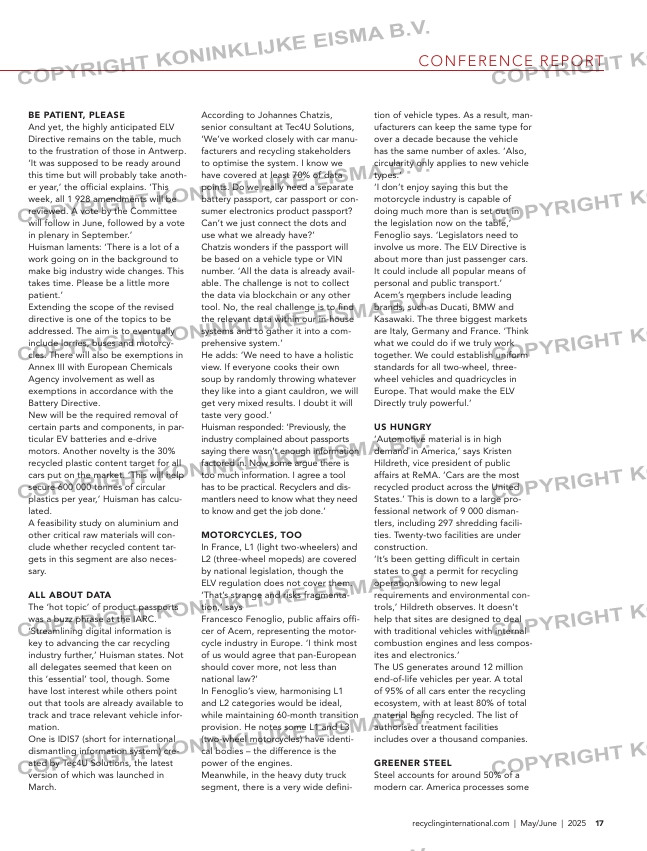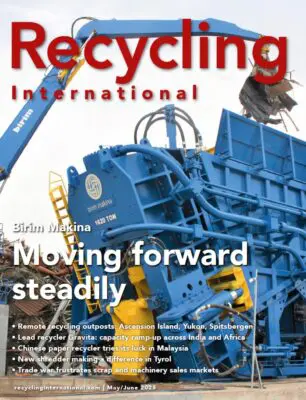Page 17 from: Recycling International May/June issue

CONFERENCE REPORT
17recyclinginternational.com | May/June | 2025
BE PATIENT, PLEASE
And yet, the highly anticipated ELV
Directive remains on the table, much
to the frustration of those in Antwerp.
‘It was supposed to be ready around
this time but will probably take anoth-
er year,’ the official explains. ‘This
week, all 1 928 amendments will be
reviewed. A vote by the Committee
will follow in June, followed by a vote
in plenary in September.’
Huisman laments: ‘There is a lot of a
work going on in the background to
make big industry wide changes. This
takes time. Please be a little more
patient.’
Extending the scope of the revised
directive is one of the topics to be
addressed. The aim is to eventually
include lorries, buses and motorcy-
cles. There will also be exemptions in
Annex III with European Chemicals
Agency involvement as well as
exemptions in accordance with the
Battery Directive.
New will be the required removal of
certain parts and components, in par-
ticular EV batteries and e-drive
motors. Another novelty is the 30%
recycled plastic content target for all
cars put on the market. ‘This will help
secure 600 000 tonnes of circular
plastics per year,’ Huisman has calcu-
lated.
A feasibility study on aluminium and
other critical raw materials will con-
clude whether recycled content tar-
gets in this segment are also neces-
sary.
ALL ABOUT DATA
The ‘hot topic’ of product passports
was a buzz phrase at the IARC.
‘Streamlining digital information is
key to advancing the car recycling
industry further,’ Huisman states. Not
all delegates seemed that keen on
this ‘essential’ tool, though. Some
have lost interest while others point
out that tools are already available to
track and trace relevant vehicle infor-
mation.
One is IDIS7 (short for international
dismantling information system) cre-
ated by Tec4U Solutions, the latest
version of which was launched in
March.
According to Johannes Chatzis,
senior consultant at Tec4U Solutions,
‘We’ve worked closely with car manu-
facturers and recycling stakeholders
to optimise the system. I know we
have covered at least 70% of data
points. Do we really need a separate
battery passport, car passport or con-
sumer electronics product passport?
Can’t we just connect the dots and
use what we already have?’
Chatzis wonders if the passport will
be based on a vehicle type or VIN
number. ‘All the data is already avail-
able. The challenge is not to collect
the data via blockchain or any other
tool. No, the real challenge is to find
the relevant data within our in-house
systems and to gather it into a com-
prehensive system.’
He adds: ‘We need to have a holistic
view. If everyone cooks their own
soup by randomly throwing whatever
they like into a giant cauldron, we will
get very mixed results. I doubt it will
taste very good.’
Huisman responded: ‘Previously, the
industry complained about passports
saying there wasn’t enough information
factored in. Now some argue there is
too much information. I agree a tool
has to be practical. Recyclers and dis-
mantlers need to know what they need
to know and get the job done.’
MOTORCYCLES, TOO
In France, L1 (light two-wheelers) and
L2 (three-wheel mopeds) are covered
by national legislation, though the
ELV regulation does not cover them.
‘That’s strange and risks fragmenta-
tion,’ says
Francesco Fenoglio, public affairs offi-
cer of Acem, representing the motor-
cycle industry in Europe. ‘I think most
of us would agree that pan-European
should cover more, not less than
national law?’
In Fenoglio’s view, harmonising L1
and L2 categories would be ideal,
while maintaining 60-month transition
provision. He notes some L1 and L3
(two-wheel motorcycles) have identi-
cal bodies – the difference is the
power of the engines.
Meanwhile, in the heavy duty truck
segment, there is a very wide defini-
tion of vehicle types. As a result, man-
ufacturers can keep the same type for
over a decade because the vehicle
has the same number of axles. ‘Also,
circularity only applies to new vehicle
types.’
‘I don’t enjoy saying this but the
motorcycle industry is capable of
doing much more than is set out in
the legislation now on the table,’
Fenoglio says. ‘Legislators need to
involve us more. The ELV Directive is
about more than just passenger cars.
It could include all popular means of
personal and public transport.’
Acem’s members include leading
brands, such as Ducati, BMW and
Kasawaki. The three biggest markets
are Italy, Germany and France. ‘Think
what we could do if we truly work
together. We could establish uniform
standards for all two-wheel, three-
wheel vehicles and quadricycles in
Europe. That would make the ELV
Directly truly powerful.’
US HUNGRY
‘Automotive material is in high
demand in America,’ says Kristen
Hildreth, vice president of public
affairs at ReMA. ‘Cars are the most
recycled product across the United
States.’ This is down to a large pro-
fessional network of 9 000 disman-
tlers, including 297 shredding facili-
ties. Twenty-two facilities are under
construction.
‘It’s been getting difficult in certain
states to get a permit for recycling
operations owing to new legal
requirements and environmental con-
trols,’ Hildreth observes. It doesn’t
help that sites are designed to deal
with traditional vehicles with internal
combustion engines and less compos-
ites and electronics.’
The US generates around 12 million
end-of-life vehicles per year. A total
of 95% of all cars enter the recycling
ecosystem, with at least 80% of total
material being recycled. The list of
authorised treatment facilities
includes over a thousand companies.
GREENER STEEL
Steel accounts for around 50% of a
modern car. America processes some
Fotobijschrift
KADERKOP
??
16-17-18-20-21-22-23_iarc2025report.indd 17 10-04-2025 11:38



